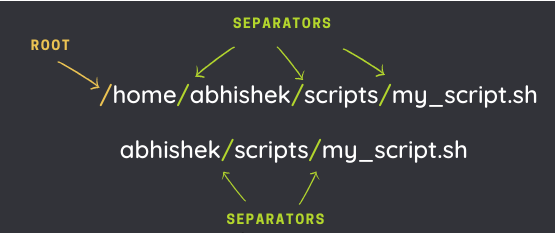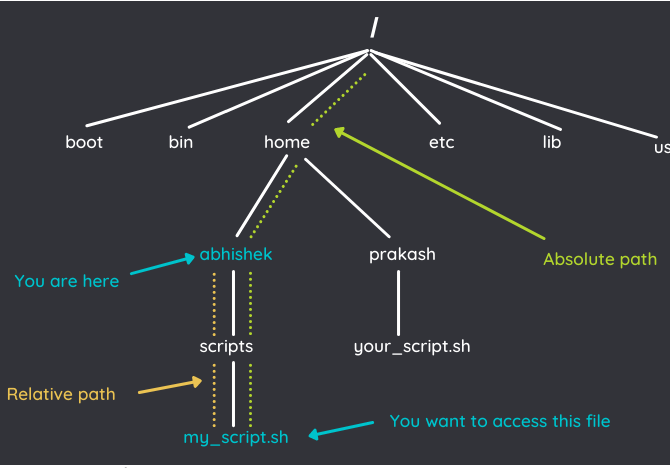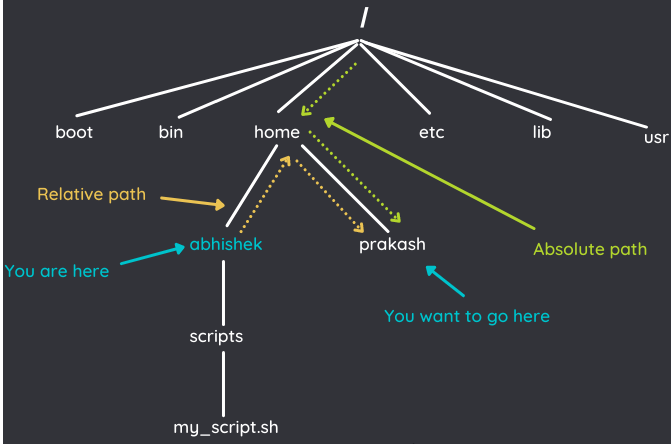 System Tutorial
System Tutorial
 LINUX
LINUX
 What is the difference between absolute paths and relative paths in Linux?
What is the difference between absolute paths and relative paths in Linux?
What is the difference between absolute paths and relative paths in Linux?
Path is a very important concept in Linux system, and every Linux user should understand it.
It refers to the location of files and directories in the Linux directory structure, consisting of names and slashes. Through paths, we can quickly find the location of files or directories.
/home/abhishek/scripts
As a system user, you use a path when you want to access a file or directory, or when you must specify the location of a file or directory for a command or script.
cat /home/abhishek/scripts/my_script.sh
Remember that if the path starts with a slash "/", the first slash represents the root and the remaining slashes in the path are just separators. Beginners often confuse the root slash with the separator slash.

In the above figure, the first path starts with the root path (/), and the second path does not start with /. Both of these ways of writing are correct, the first is an absolute path and the second is a relative path.
Absolute paths and relative paths in Linux
Absolute paths always start from the root directory (/), such as:
/home/abhishek/scripts/my_scripts.sh
Relative paths start from the current directory. For example, if you are in the /home directory and want to access the my_script.sh file, the access path should be:
abhishek/scripts/my_scripts.sh
Understand the difference between absolute paths and relative paths
We all know that the directory structure in Linux is a tree, starting from the root (/) and then generating branches.
Assume that we are now in the directory abhishek and want to access the file my_scripts.sh, as shown in the following figure showing the two paths:

Suppose we use the ls command to view the file information of my_script.sh, then use the absolute path:
ls -l /home/abhishek/scripts/my_script.sh
Then, relative path:
ls -l scripts/my_script.sh
Then, except for the different file paths, the above two methods are exactly the same:

Note: In Linux, file names are case-sensitive. Can have uppercase, lowercase, numbers, dots, dashes, underlines, and most characters except slash (/). The slash (/) is a reserved character used in root directories and used to separate directories in a path.
Use relative paths with . and .. directories
**
**
There are two special relative paths:
- .**** (a dot) : Indicates the current path in the path;
- ..**** (two dots) : Indicates the parent directory, that is, the upper-level directory.
As shown below, we need to go from the abhishek directory to the prakash directory.

To switch directories, use the cd command. If you use an absolute path, you can do this:
cd /home/prakash
If you use a relative path, you need to use a special relative path.. :
cd ../prakash
Why use ..? Since the relative path starts from the current directory, we need to tell the cd command to go up one level, taking us to the /home directory and from there into the prakash directory.
Absolute paths always start with / and are independent of the current location; relative paths depend on the current location.
Absolute path or relative path, which one should be used?
Honestly, there is no straightforward answer to this question. It depends.
If the directory hierarchy you are currently in is relatively deep and you need to move up or down one level, it is easier to use relative paths.
Assuming you are located in
/home/username/programming/project/interface/src/header directory, and needs to access something in the /home/username/programming/project/interface/bin directory. Using a relative path avoids typing all that lengthy directory name, just use .././bin here.
However, if you want to access something in the /usr/bin directory from the /home/username/programming/project/interface/src/header directory, then use ../../../../ ../../usr/bin will be more troublesome. In this case, it is more convenient to use the absolute path.
Another situation is to use the path in a script or program. If the location is certain, use an absolute path; if you have multiple folders in the project and need to switch between them, use a relative path here because you are not sure where the end user will put the program. .
The above is the detailed content of What is the difference between absolute paths and relative paths in Linux?. For more information, please follow other related articles on the PHP Chinese website!

Hot AI Tools

Undresser.AI Undress
AI-powered app for creating realistic nude photos

AI Clothes Remover
Online AI tool for removing clothes from photos.

Undress AI Tool
Undress images for free

Clothoff.io
AI clothes remover

Video Face Swap
Swap faces in any video effortlessly with our completely free AI face swap tool!

Hot Article

Hot Tools

Notepad++7.3.1
Easy-to-use and free code editor

SublimeText3 Chinese version
Chinese version, very easy to use

Zend Studio 13.0.1
Powerful PHP integrated development environment

Dreamweaver CS6
Visual web development tools

SublimeText3 Mac version
God-level code editing software (SublimeText3)

Hot Topics
 1657
1657
 14
14
 1415
1415
 52
52
 1309
1309
 25
25
 1257
1257
 29
29
 1230
1230
 24
24
 Linux Architecture: Unveiling the 5 Basic Components
Apr 20, 2025 am 12:04 AM
Linux Architecture: Unveiling the 5 Basic Components
Apr 20, 2025 am 12:04 AM
The five basic components of the Linux system are: 1. Kernel, 2. System library, 3. System utilities, 4. Graphical user interface, 5. Applications. The kernel manages hardware resources, the system library provides precompiled functions, system utilities are used for system management, the GUI provides visual interaction, and applications use these components to implement functions.
 vscode terminal usage tutorial
Apr 15, 2025 pm 10:09 PM
vscode terminal usage tutorial
Apr 15, 2025 pm 10:09 PM
vscode built-in terminal is a development tool that allows running commands and scripts within the editor to simplify the development process. How to use vscode terminal: Open the terminal with the shortcut key (Ctrl/Cmd). Enter a command or run the script. Use hotkeys (such as Ctrl L to clear the terminal). Change the working directory (such as the cd command). Advanced features include debug mode, automatic code snippet completion, and interactive command history.
 How to check the warehouse address of git
Apr 17, 2025 pm 01:54 PM
How to check the warehouse address of git
Apr 17, 2025 pm 01:54 PM
To view the Git repository address, perform the following steps: 1. Open the command line and navigate to the repository directory; 2. Run the "git remote -v" command; 3. View the repository name in the output and its corresponding address.
 How to run java code in notepad
Apr 16, 2025 pm 07:39 PM
How to run java code in notepad
Apr 16, 2025 pm 07:39 PM
Although Notepad cannot run Java code directly, it can be achieved by using other tools: using the command line compiler (javac) to generate a bytecode file (filename.class). Use the Java interpreter (java) to interpret bytecode, execute the code, and output the result.
 How to run sublime after writing the code
Apr 16, 2025 am 08:51 AM
How to run sublime after writing the code
Apr 16, 2025 am 08:51 AM
There are six ways to run code in Sublime: through hotkeys, menus, build systems, command lines, set default build systems, and custom build commands, and run individual files/projects by right-clicking on projects/files. The build system availability depends on the installation of Sublime Text.
 vscode Previous Next Shortcut Key
Apr 15, 2025 pm 10:51 PM
vscode Previous Next Shortcut Key
Apr 15, 2025 pm 10:51 PM
VS Code One-step/Next step shortcut key usage: One-step (backward): Windows/Linux: Ctrl ←; macOS: Cmd ←Next step (forward): Windows/Linux: Ctrl →; macOS: Cmd →
 What is the main purpose of Linux?
Apr 16, 2025 am 12:19 AM
What is the main purpose of Linux?
Apr 16, 2025 am 12:19 AM
The main uses of Linux include: 1. Server operating system, 2. Embedded system, 3. Desktop operating system, 4. Development and testing environment. Linux excels in these areas, providing stability, security and efficient development tools.
 laravel installation code
Apr 18, 2025 pm 12:30 PM
laravel installation code
Apr 18, 2025 pm 12:30 PM
To install Laravel, follow these steps in sequence: Install Composer (for macOS/Linux and Windows) Install Laravel Installer Create a new project Start Service Access Application (URL: http://127.0.0.1:8000) Set up the database connection (if required)



